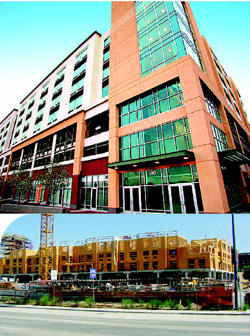McAlvain, for instance, specified Civic Plaza Apartments as a wood-framed building—one that demanded 30-plus railcars of fire-treated and dimensional lumber priced at nearly $1 million. “We were able to frame it faster than if it had been built out of steel,” says Trace Leighton, president of Leighton Enterprises, the framing contractor, citing both the on-site flexibility of wood framing and the need for fewer subcontractors to complete the job, which saved time and labor costs.
Often placed on tight lots, however, infill projects present a logistical challenge to both builders and their suppliers. With no staging area to store or secure material, McAlvain, Leighton, and BMC West (the local supplier) agreed that the dealer would inventory the lumber and deliver it as needed to the site. Leighton received up to 15 trailer-loads of lumber a week during construction, placing materials from each truck onto the building’s platforms with a tower crane.
In addition to tight lots, Bissette’s suppliers and contractors also contend with narrow streets and security issues. “Access and logistics can be very difficult,” he says. “And the high crime rate makes it unappealing.”
So much so that Bissette had to alter his business model a bit to assure suppliers that he could make the project work. “When you approach them about detached infill housing, they tend to think you have no money or are a less-sophisticated builder,” he says of some of the suppliers he encountered in both Jacksonville and Atlanta. “You have to keep selling homes and paying on time to prove to them that you’re legit.”
To do that, Bissette runs a tight, 120-day schedule from foundation to completion and uses an automated project management and accounting system to boost efficiency and make sure bills are paid on time and in full. He also demands a higher level of quality—in both materials and labor—that most suburban-focused suppliers can’t match, which weeds out all but a few possible partners.
Without a doubt, Bissette is among a relatively small contingency of home builders and developers who see the long-term potential for urban infill housing—one that savvy dealers also can participate in by supporting existing customers moving into the city with the services and products they need to succeed, including trucks and equipment that accommodate limited jobsite access, just-in-time or on-call delivery, and sources to products (such as fire-treated lumber) that builders may be required to use in urban housing projects.
It takes a collaborative effort between the entire supply chain to keep the infill momentum because for every Jacksonville that has developed a strategic plan for encouraging such development, there remains other cities where infill is less supported and perhaps discouraged. “Compared to the overall housing market, infill is a small percentage right now,” says Tombari. “But there’s a definite trend in most cities where more people want to live and work in that environment.”—Rich Binsacca is a contributing editor to PROSALES.
Infill Indicators Look for one or more of these signs as indicators that infill housing is supported and sustainable in your market.



